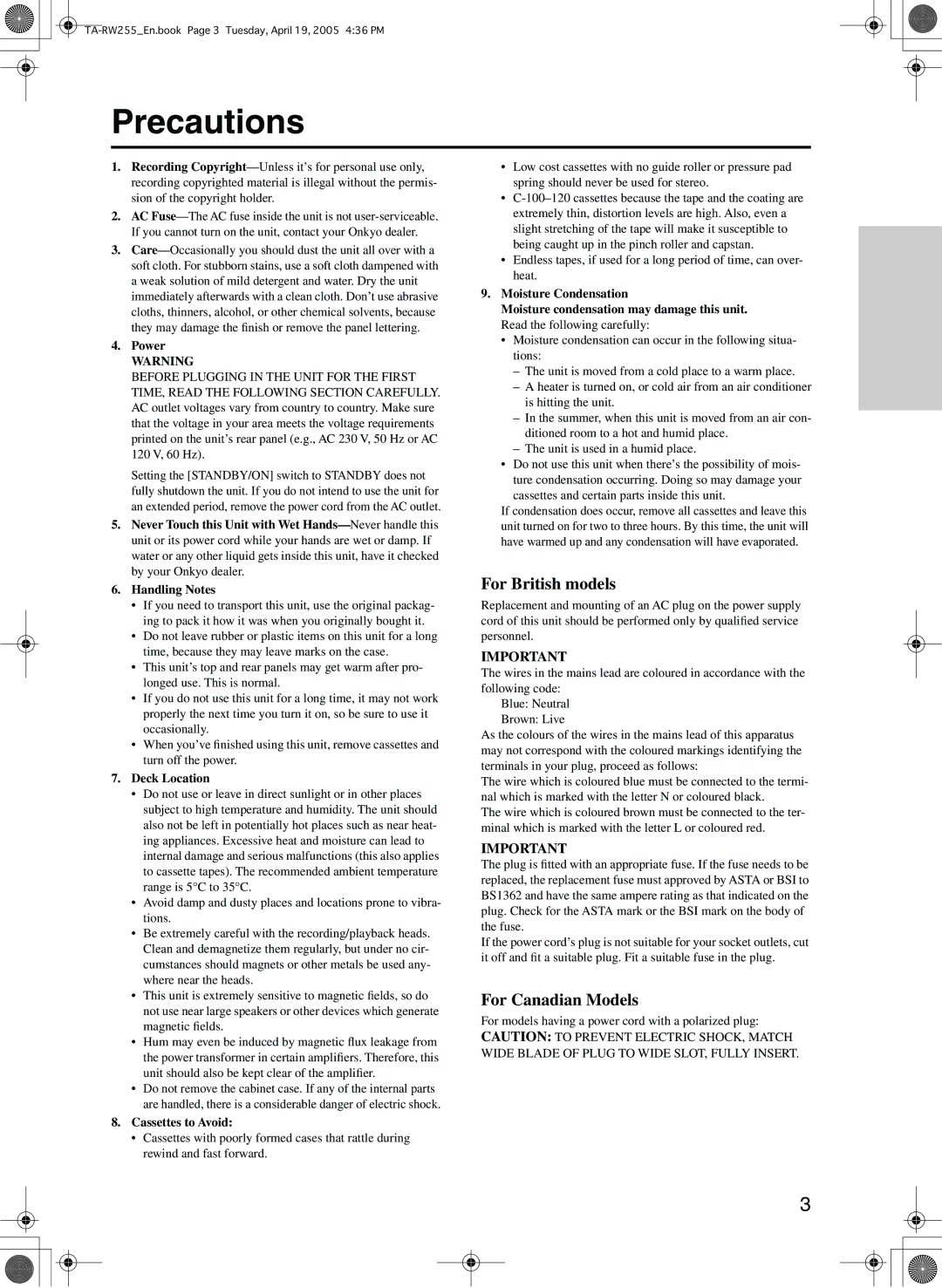1.Recording Copyright—Unless it’s for personal use only, recording copyrighted material is illegal without the permis- sion of the copyright holder.
2.AC Fuse—The AC fuse inside the unit is not user-serviceable. If you cannot turn on the unit, contact your Onkyo dealer.
3.Care—Occasionally you should dust the unit all over with a soft cloth. For stubborn stains, use a soft cloth dampened with a weak solution of mild detergent and water. Dry the unit immediately afterwards with a clean cloth. Don’t use abrasive cloths, thinners, alcohol, or other chemical solvents, because they may damage the finish or remove the panel lettering.
4.Power
WARNING
BEFORE PLUGGING IN THE UNIT FOR THE FIRST TIME, READ THE FOLLOWING SECTION CAREFULLY. AC outlet voltages vary from country to country. Make sure that the voltage in your area meets the voltage requirements printed on the unit’s rear panel (e.g., AC 230 V, 50 Hz or AC 120 V, 60 Hz).
Setting the [STANDBY/ON] switch to STANDBY does not fully shutdown the unit. If you do not intend to use the unit for an extended period, remove the power cord from the AC outlet.
5.Never Touch this Unit with Wet Hands—Never handle this unit or its power cord while your hands are wet or damp. If water or any other liquid gets inside this unit, have it checked by your Onkyo dealer.
6.Handling Notes
•If you need to transport this unit, use the original packag- ing to pack it how it was when you originally bought it.
•Do not leave rubber or plastic items on this unit for a long time, because they may leave marks on the case.
•This unit’s top and rear panels may get warm after pro- longed use. This is normal.
•If you do not use this unit for a long time, it may not work properly the next time you turn it on, so be sure to use it occasionally.
•When you’ve finished using this unit, remove cassettes and turn off the power.
7.Deck Location
•Do not use or leave in direct sunlight or in other places subject to high temperature and humidity. The unit should also not be left in potentially hot places such as near heat- ing appliances. Excessive heat and moisture can lead to internal damage and serious malfunctions (this also applies to cassette tapes). The recommended ambient temperature range is 5°C to 35°C.
•Avoid damp and dusty places and locations prone to vibra- tions.
•Be extremely careful with the recording/playback heads. Clean and demagnetize them regularly, but under no cir- cumstances should magnets or other metals be used any- where near the heads.
•This unit is extremely sensitive to magnetic fields, so do not use near large speakers or other devices which generate magnetic fields.
•Hum may even be induced by magnetic flux leakage from the power transformer in certain amplifiers. Therefore, this unit should also be kept clear of the amplifier.
•Do not remove the cabinet case. If any of the internal parts are handled, there is a considerable danger of electric shock.
8.Cassettes to Avoid:
•Low cost cassettes with no guide roller or pressure pad spring should never be used for stereo.
•C-100–120 cassettes because the tape and the coating are extremely thin, distortion levels are high. Also, even a slight stretching of the tape will make it susceptible to being caught up in the pinch roller and capstan.
•Endless tapes, if used for a long period of time, can over- heat.
9.Moisture Condensation
Moisture condensation may damage this unit. Read the following carefully:
•Moisture condensation can occur in the following situa- tions:
–The unit is moved from a cold place to a warm place.
–A heater is turned on, or cold air from an air conditioner is hitting the unit.
–In the summer, when this unit is moved from an air con- ditioned room to a hot and humid place.
–The unit is used in a humid place.
•Do not use this unit when there’s the possibility of mois- ture condensation occurring. Doing so may damage your cassettes and certain parts inside this unit.
If condensation does occur, remove all cassettes and leave this unit turned on for two to three hours. By this time, the unit will have warmed up and any condensation will have evaporated.
For British models
Replacement and mounting of an AC plug on the power supply cord of this unit should be performed only by qualified service personnel.
IMPORTANT
The wires in the mains lead are coloured in accordance with the following code:
Blue: Neutral
Brown: Live
As the colours of the wires in the mains lead of this apparatus may not correspond with the coloured markings identifying the terminals in your plug, proceed as follows:
The wire which is coloured blue must be connected to the termi- nal which is marked with the letter N or coloured black.
The wire which is coloured brown must be connected to the ter- minal which is marked with the letter L or coloured red.
IMPORTANT
The plug is fitted with an appropriate fuse. If the fuse needs to be replaced, the replacement fuse must approved by ASTA or BSI to BS1362 and have the same ampere rating as that indicated on the plug. Check for the ASTA mark or the BSI mark on the body of the fuse.
If the power cord’s plug is not suitable for your socket outlets, cut it off and fit a suitable plug. Fit a suitable fuse in the plug.
For Canadian Models
For models having a power cord with a polarized plug:
CAUTION: TO PREVENT ELECTRIC SHOCK, MATCH WIDE BLADE OF PLUG TO WIDE SLOT, FULLY INSERT.

